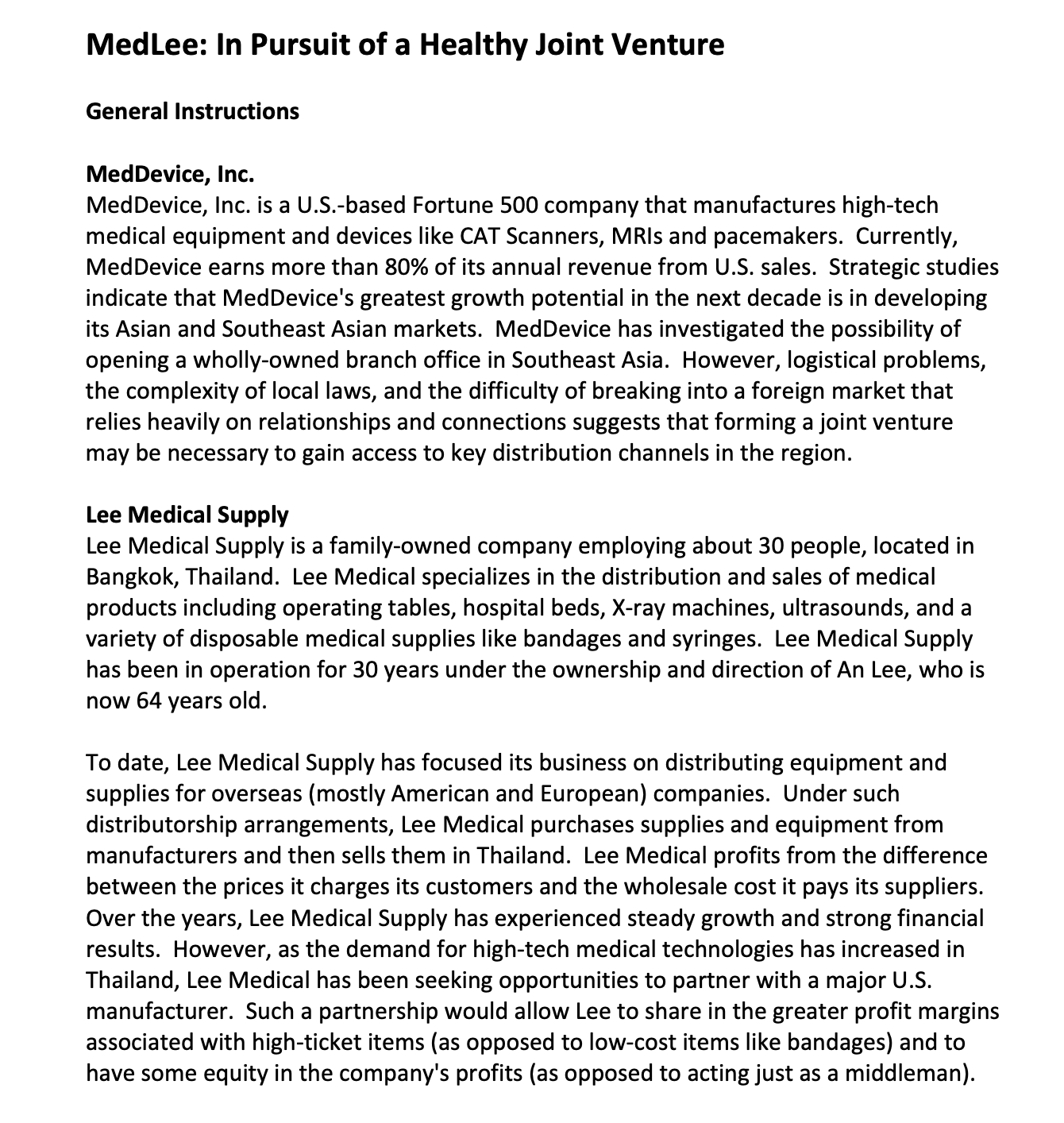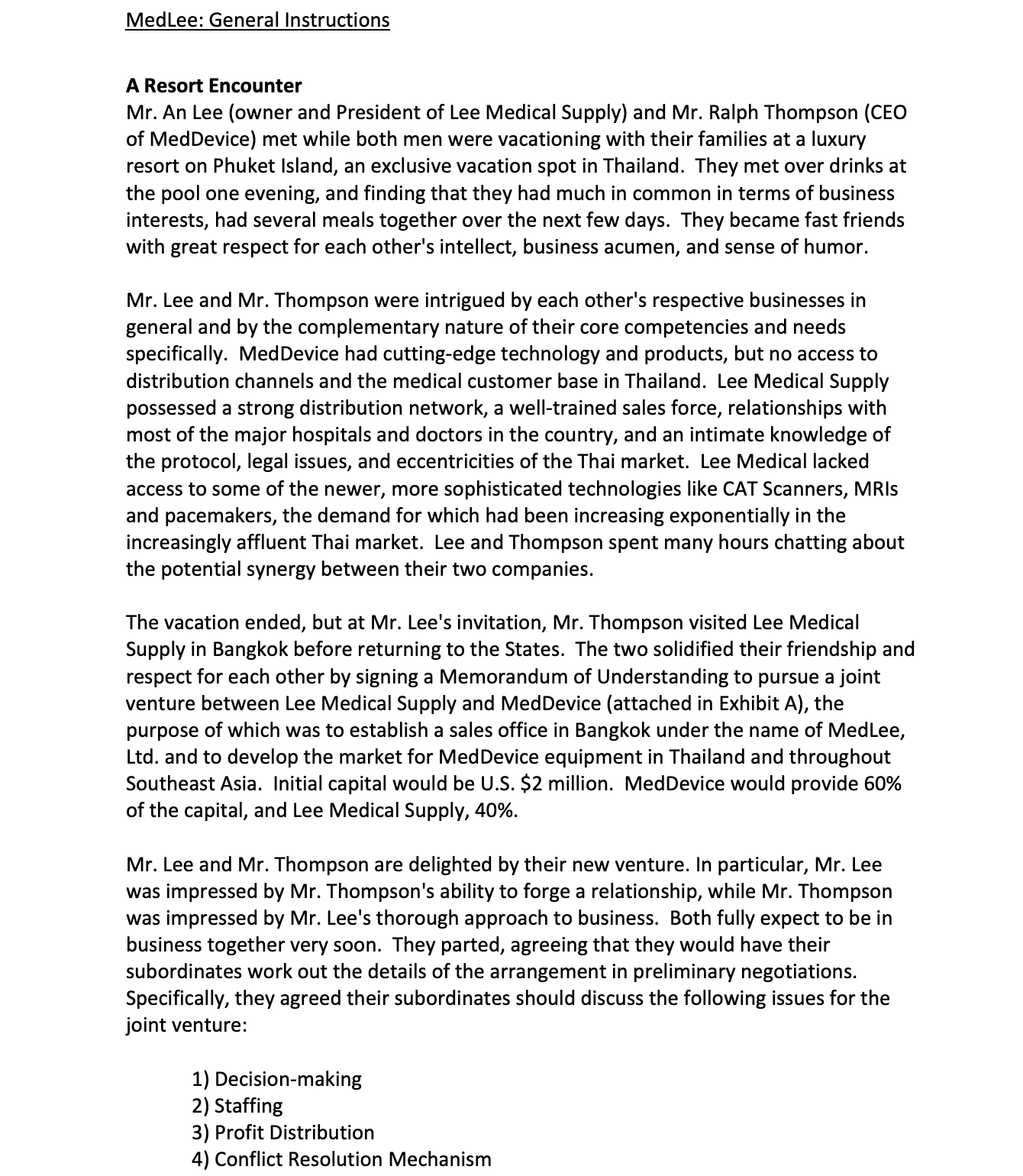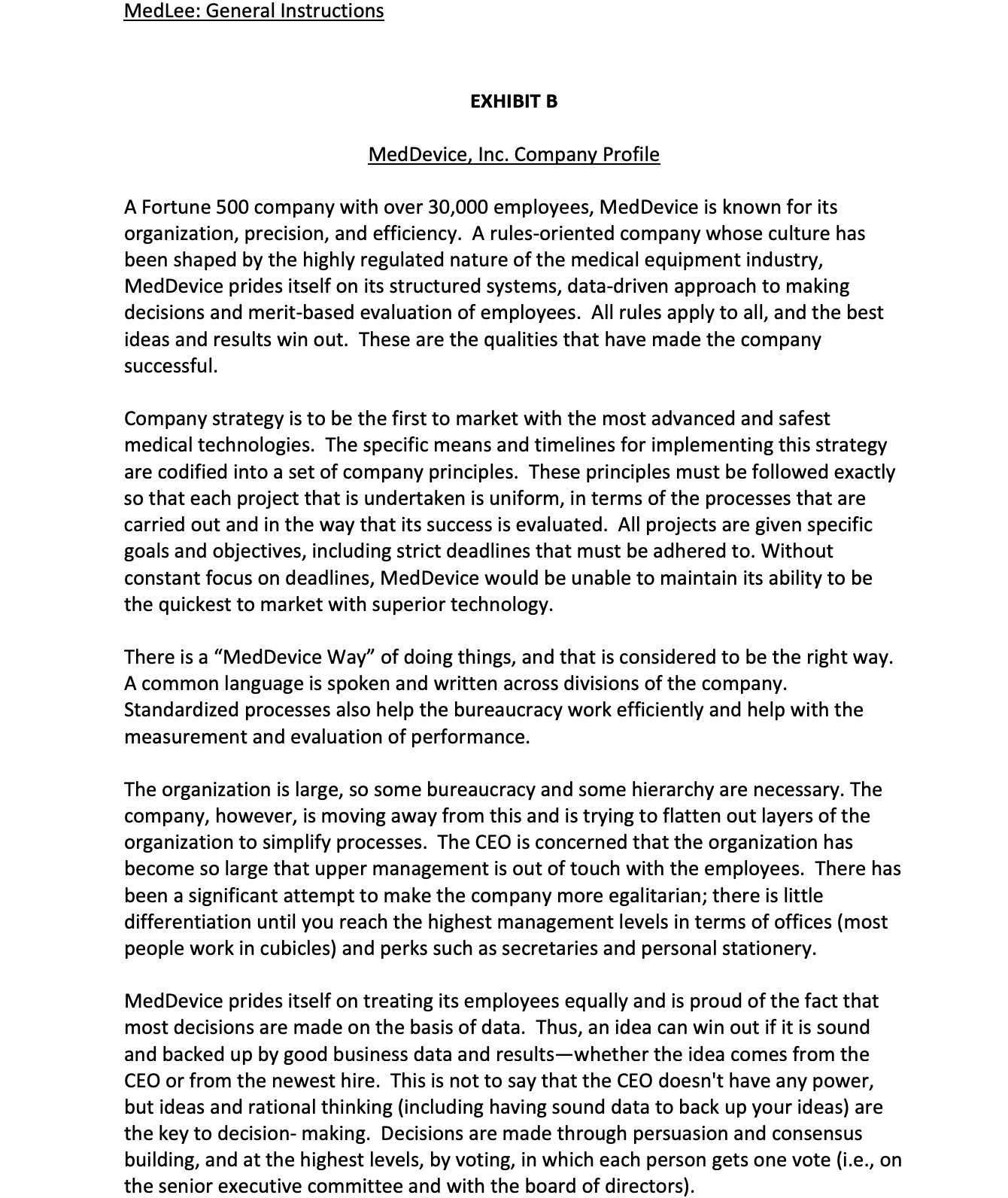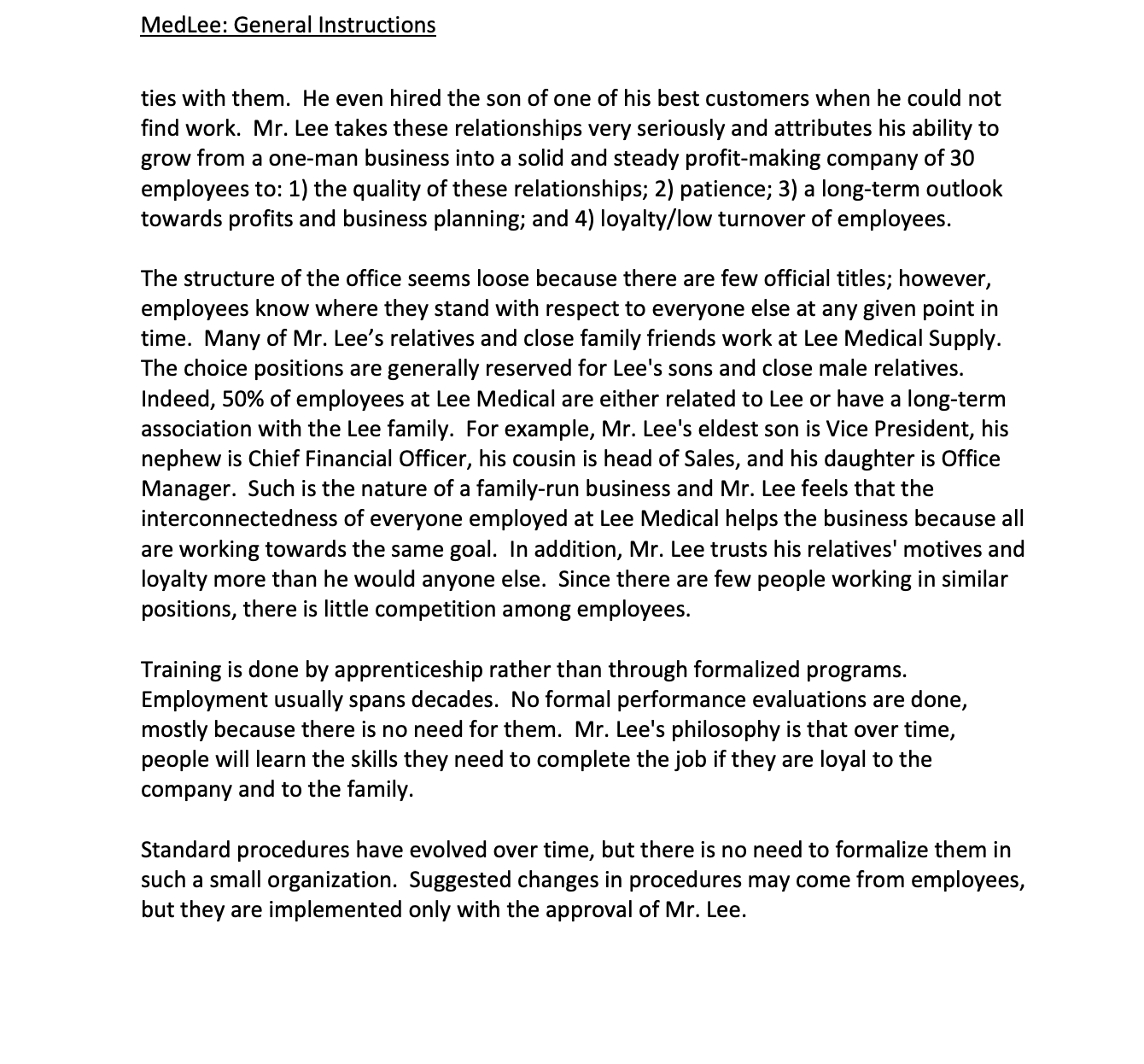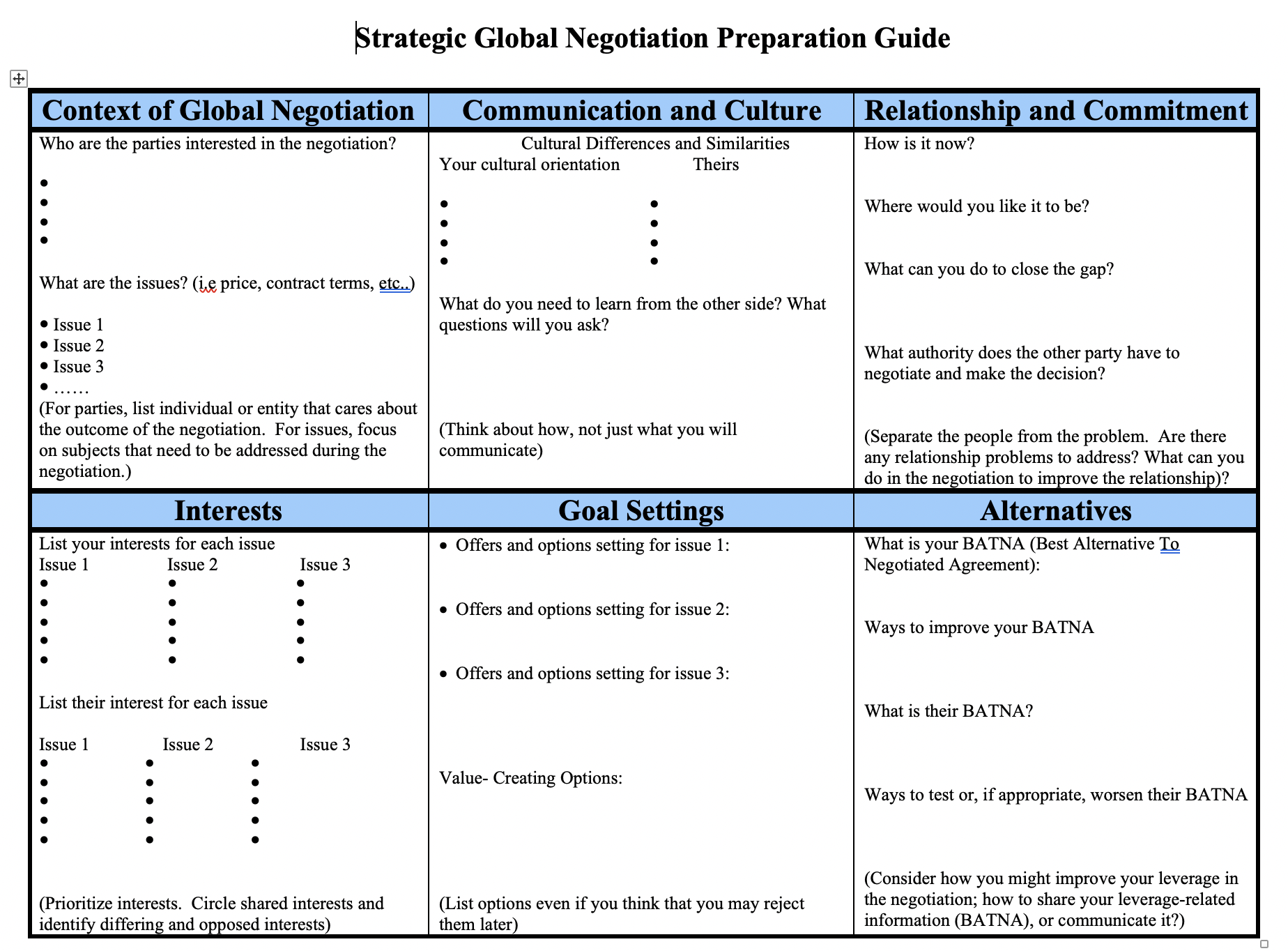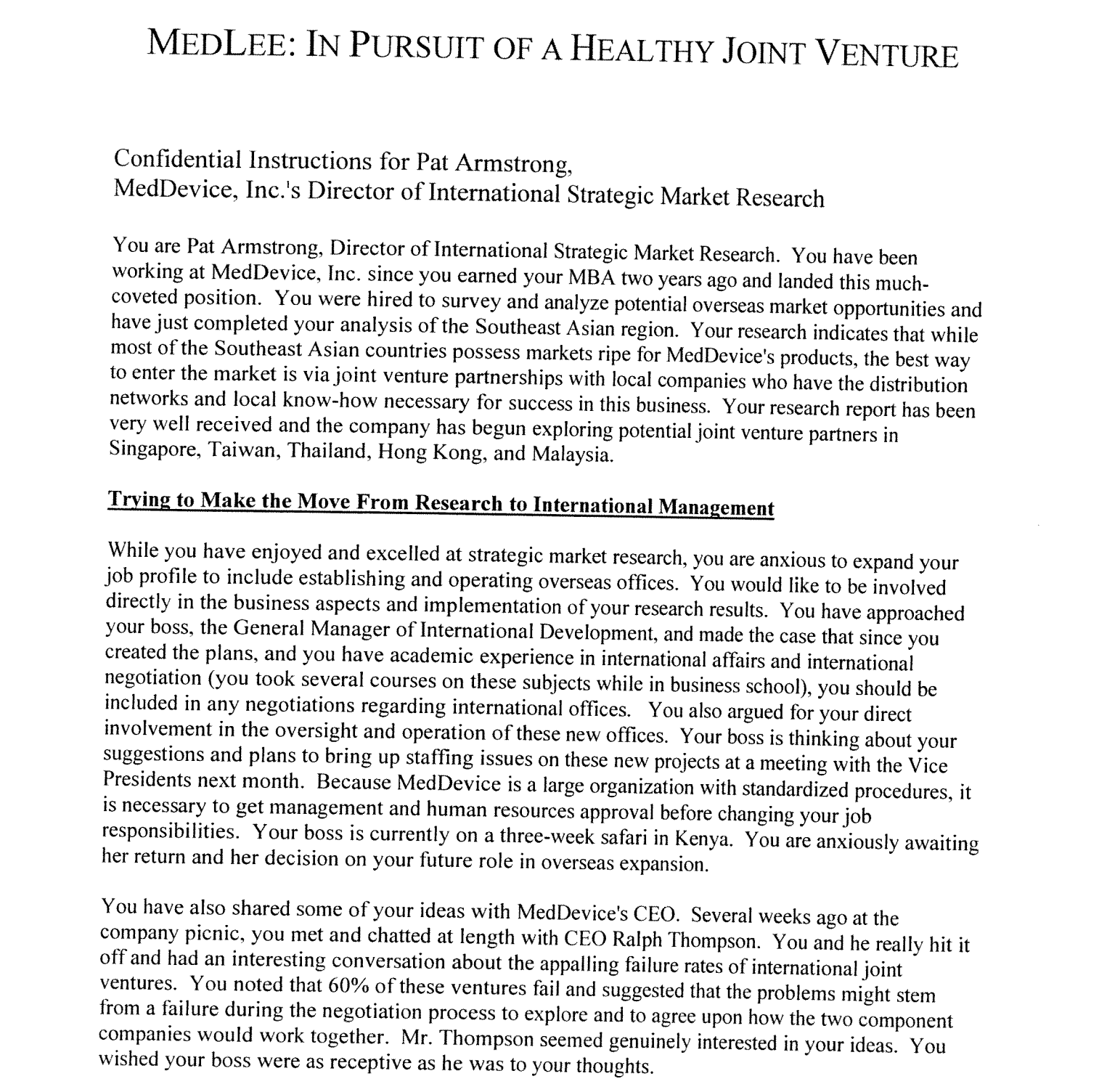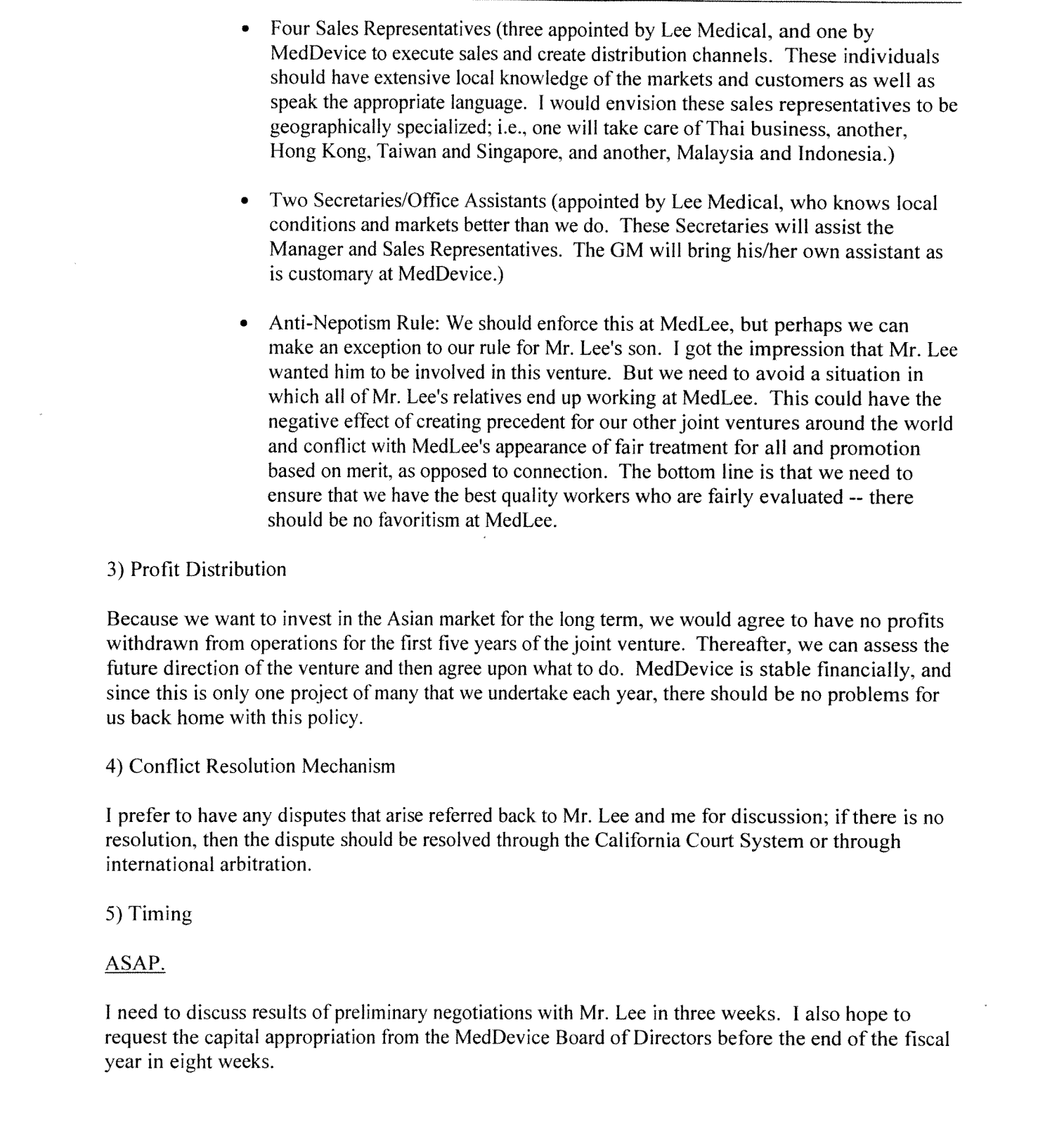Please need to read Medlee case and your own individual Profile (Your are Armstrong) and compleetee the Strategic Global Negotiation Preparation Guide Worksheet. Thank you
MEDDLE CASE:
MedLee: In Pursuit of a Healthy Joint Venture General Instructions MedDevice, Inc. MedDevice, Inc. is a U.S.-based Fortune 500 company that manufactures high-tech medical equipment and devices like CAT Scanners, MRls and pacemakers. Currently, MedDevice earns more than 80% of its annual revenue from U.S. sales. Strategic studies indicate that MedDevice's greatest growth potential in the next decade is in developing its Asian and Southeast Asian markets. MedDevice has investigated the possibility of opening a wholly-owned branch office in Southeast Asia. However, logistical problems, the complexity of local laws, and the difficulty of breaking into a foreign market that relies heavily on relationships and connections suggests that forming a joint venture may be necessary to gain access to key distribution channels in the region. Lee Medical Supply Lee Medical Supply is a family-owned company employing about 30 people, located in Bangkok, Thailand. Lee Medical specializes in the distribution and sales of medical products including operating tables, hospital beds, X-ray machines, ultrasounds, and a variety of disposable medical supplies like bandages and syringes. Lee Medical Supply has been in operation for 30 years under the ownership and direction of An Lee, who is now 64 years old. To date, Lee Medical Supply has focused its business on distributing equipment and supplies for overseas (mostly American and European) companies. Under such distributorship arrangements, Lee Medical purchases supplies and equipment from manufacturers and then sells them in Thailand. Lee Medical profits from the difference between the prices it charges its customers and the wholesale cost it pays its suppliers. Over the years, Lee Medical Supply has experienced steady growth and strong financial results. However, as the demand for high-tech medical technologies has increased in Thailand, Lee Medical has been seeking opportunities to partner with a major U.S. manufacturer. Such a partnership would allow Lee to share in the greater profit margins associated with high-ticket items (as opposed to low-cost items like bandages) and to have some equity in the company's profits (as opposed to actingjust as a middleman). MedLee: General Instructions A Resort Encounter Mr. An Lee (owner and President of Lee Medical Supply) and Mr. Ralph Thompson (CEO of MedDevice) met while both men were vacationing with their families at a luxury resort on Phuket Island, an exclusive vacation spot in Thailand. They met over drinks at the pool one evening, and finding that they had much in common in terms of business interests, had several meals together over the next few days. They became fast friends with great respect for each other's intellect, business acumen, and sense of humor. Mr. Lee and Mr. Thompson were intrigued by each other's respective businesses in general and by the complementary nature of their core competencies and needs specically. MedDevice had cutting-edge technology and products, but no access to distribution channels and the medical customer base in Thailand. Lee Medical Supply possessed a strong distribution network, a well-trained sales force, relationships with most of the major hospitals and doctors in the country, and an intimate knowledge of the protocol, legal issues, and eccentricities of the Thai market. Lee Medical lacked access to some of the newer, more sophisticated technologies like CAT Scanners, MRIs and pacemakers, the demand for which had been increasing exponentially in the increasingly affluent Thai market. Lee and Thompson spent many hours chatting about the potential synergy between their two companies. The vacation ended, but at Mr. Lee's invitation, Mr. Thompson visited Lee Medical Supply in Bangkok before returning to the States. The two solidified their friendship and respect for each other by signing a Memorandum of Understanding to pursue a joint venture between Lee Medical Supply and MedDevice (attached in Exhibit A), the purpose of which was to establish a sales office in Bangkok under the name of MedLee, Ltd. and to develop the market for MedDevice equipment in Thailand and throughout Southeast Asia. Initial capital would be US. $2 million. MedDevice would provide 60% of the capital, and Lee Medical Supply, 40%. Mr. Lee and Mr. Thompson are delighted by their new venture. In particular, Mr. Lee was impressed by Mr. Thompson's ability to forge a relationship, while Mr. Thompson was impressed by Mr. Lee's thorough approach to business. Both fully expect to be in business together very soon. They parted, agreeing that they would have their subordinates work out the details of the arrangement in preliminary negotiations. Specically, they agreed their subordinates should discuss the following issues for the joint venture: 1) Decision-making 2) Staffing 3) Profit Distribution 4) Conflict Resolution Mechanism MedLee: General Instructions Mr. Lee and Mr. Thompson would meet at MedDevice headquarters in three weeks {when Mr. Lee would be in the States on other business) to review the results of the preliminary negotiations. You will be conducting preliminary negotiations as either a representative of MedDevice, Inc. or Lee Medical Supply. You recently read an article stating that 60% of all joint ventures fail within four years. How would you prepare for your discussion with your counterpart? In particular, what concern might you have about cultural differences between MedDevice and Lee Medical Supply? Profiles of the two companies are attached in Exhibits B and C. EXHIBIT A Memorandum of Understanding Following our cordial conversations over the last few days, it is in our mutual interest to establish a joint venture to be called MedLee, Ltd. in Thailand to undertake the sale and distribution, in Thailand and Southeast Asia, of high-technology medical equipment manufactured by MedDevice. The initial capitalization of the joint venture will be U.S. $2,000,000, and the initial period of the venture will be ve years. MedDevice, Inc. will contribute 60% of the capital and Lee Medical Supply will contribute 40%. We agree that representatives of our two companies will meet within 30 days to negotiate the details of this arrangement. An Lee Ralph Thompson President CEO Lee Medical Supply MedDevice, Inc. Golden Sands Resort Phuket Island Thailand MedLee: General Instructions EXHIBIT B MedDevice, Inc. Company Profile A Fortune 500 company with over 30,000 employees, MedDevice is known for its organization, precision, and efficiency. A rules-oriented company whose culture has been shaped by the highly regulated nature of the medical equipment industry, Med Device prides itself on its structured systems, data-driven approach to making decisions and merit-based evaluation of employees. All rules apply to all, and the best ideas and results win out. These are the qualities that have made the company successful. Company strategy is to be the first to market with the most advanced and safest medical technologies. The specific means and timelines for implementing this strategy are codified into a set of company principles. These principles must be followed exactly so that each project that is undertaken is uniform, in terms of the processes that are carried out and in the way that its success is evaluated. All projects are given specific goals and objectives, including strict deadlines that must be adhered to. Without constant focus on deadlines, MedDevice would be unable to maintain its ability to be the quickest to market with superior technology. There is a "MedDevice Way\" of doing things, and that is considered to be the right way. A common language is spoken and written across divisions of the company. Standardized processes also help the bureaucracy work efficiently and help with the measurement and evaluation of performance. The organization is large, so some bureaucracy and some hierarchy are necessary. The company, however, is moving away from this and is trying to flatten out layers of the organization to simplify processes. The CEO is concerned that the organization has become so large that upper management is out of touch with the employees. There has been a significant attempt to make the company more egalitarian; there is little differentiation until you reach the highest management levels in terms of offices (most people work in cubicles) and perks such as secretaries and personal stationery. MedDevice prides itself on treating its employees equally and is proud of the fact that most decisions are made on the basis of data. Thus, an idea can win out if it is sound and backed up by good business data and resultswhether the idea comes from the CEO or from the newest hire. This is not to say that the CEO doesn't have any power, but ideas and rational thinking (including having sound data to back up your ideas) are the key to decision- making. Decisions are made through persuasion and consensus building, and at the highest levels, by voting, in which each person gets one vote (i.e., on the senior executive committee and with the board of directors). MedLee: General Instructions Performance and business results on an individual basis are measured and rewarded. MedDevice operates on an "up or out\" policy. That is, employees are evaluated annually, and are retained or promoted if their performance is up to par. Those who do not make the cut are counseled out or moved to other divisions. While much of the work is performed in teams, an individual's achievement is rewarded in accordance with his or her specific contribution to team effort. Everything, it seems, is quantied and measured. The saying goes at MedDevice, \"If you cannot measure it, it will not (or even did not) happen.\" This policy ensures that the best workers are retained and promoted and that they are evaluated on the basis of agreed-upon objective standards, rather than on subjective factors. This dedication to ensuring merit-based evaluation of employees manifests itself also in an anti-nepotism rule. Close relatives of any employee who is in upper management (General Manager level and above, including General Managers, Vice Presidents, CFO, and CEO) cannot be hired by MedDevice. If members of upper management have relatives who were already working at MedDevice prior to their promotion into upper management, their relatives can continue their employment, on the condition that someone to whom they are related will never evaluate them. In some cases this has required people to quit or to transfer to divisions far from the purview of their relatives. This further ensures fairness within the organization and equality of opportunities. {Close relatives in this context include spouses, children, sisters, brothers, uncles, aunts, cousins, nephews, and nieces of the employee in upper management). EXHIBIT C Lee Medical Supply Company Profile Lee Medical Supply is fairly typical of the small, family-run and owned businesses in Thailand and other parts of Southeast Asia. The Company was started 30 years ago by An Lee, who remains owner and President. His seniority and experience is well respectedafter all, he built the company from the ground up and has nurtured its development and growth into a protable venture. What Mr. Lee says generally goes; employees respond, for the most part to both the letter and spirit of his directives. Decisions are made from above and executed with little discussion or dissension by the subordinates. The key to Lee Medical Supply's success and growth over the years has been its cultivation of long-term relationships with its suppliers and customers. Mr. Lee sees himself as a partner to suppliers and customers, and he maintains close and frequent MedLee: General Instructions ties with them. He even hired the son of one of his best customers when he could not find work. Mr. Lee takes these relationships very seriously and attributes his ability to grow from a one-man business into a solid and steady profit-making company of 30 employees to: 1) the quality of these relationships; 2) patience; 3) a long-term outlook towards prots and business planning; and 4) loyalty/low turnover of employees. The structure of the office seems loose because there are few official titles; however, employees know where they stand with respect to everyone else at any given point in time. Many of Mr. Lee's relatives and close family friends work at Lee Medical Supply. The choice positions are generally reserved for Lee's sons and close male relatives. Indeed, 50% of employees at Lee Medical are either related to Lee or have a long-term association with the Lee family. For example, Mr. Lee's eldest son is Vice President, his nephew is Chief Financial Officer, his cousin is head of Sales, and his daughter is Ofce Manager. Such is the nature of a family-run business and Mr. Lee feels that the interconnectedness of everyone employed at Lee Medical helps the business because all are working towards the same goal. In addition, Mr. Lee trusts his relatives' motives and loyalty more than he would anyone else. Since there are few people working in similar positions, there is little competition among employees. Training is done by apprenticeship rather than through formalized programs. Employment usually spans decades. No formal performance evaluations are done, mostly because there is no need for them. Mr. Lee's philosophy is that over time, people will learn the skills they need to complete the job if they are loyal to the company and to the family. Standard procedures have evolved over time, but there is no need to formalize them in such a small organization. Suggested changes in procedures may come from employees, but they are implemented only with the approval of Mr. Lee. Strategic Global Negotiation Preparation Guide Who are the parties interested in the negotiation? What are the issues? (Le, price, contract terms, etc\") 0 Issue 1 0 Issue 2 0 Issue 3 (For parties, list individual or entity that cares about the outcome of the negotiation. For issues, focus on subjects that need to be addressed during the negotiation.) List your interests for each issue Issue 1 Issue 2 Issue 3 I I I I I I I I I I I I I I I List their interest for each issue Issue 1 Issue 2 Issue 3 I I I I I I I I I I I I I I I (Prioritize interests. Circle shared interests and identi di'erin and o osed interests Cultural Differences and Similarities Your cultural orientation Theirs I I I I I I I I What do you need to learn from the other side? What questions will you ask? (Think about how, not just What you will communicate) t Offers and options setting for issue 1: 0 Offers and options setting for issue 2: t O'ers and options setting for issue 3: Value Creating Options: (List options even if you think that you may reject them later How is it now? Where would you like it to be? What can you do to close the gap? What authority does the other party have to negotiate and make the decision? (Separate the people from the problem. Are there any relationship problems to address? What can you do in the ne otiation to im rove the relationshi ? What is your BATNA (Best Alternative E Negotiated Agreement): Ways to improve your BATNA What is their BATNA? Ways to test or, if appropriate, worsen their BATNA (Consider how you might improve your leverage in the negotiation; how to share your leveragerelated information (BATNA), or communicate it?) MEDLEE: IN PURSUIT OF A HEALTHY JOINT VENTURE Condential Instructions for Pat Armstrong, MedDevice, Inc's Director of International Strategic Market Research You are Pat Armstrong, Director of International Strategic Market Research. You have been working at MedDevice, inc. since you earned your MBA two years ago and landed this much- coveted position. You were hired to survey and analyze potential overseas market opportunities and have just completed your analysis of the Southeast Asian region. Your research indicates that while most of the Southeast Asian countries possess markets ripe for MedDevice's products, the best way to enter the market is via joint venture partnerships with local companies who have the distribution networks and local know-how necessary for success in this business. Your research report has been very well received and the company has begun exploring potential joint venture partners in Singapore, Taiwan, Thailand, Hong Kong, and Malaysia. Trying to Make the Move From Research to International Management While you have enjoyed and excelled at strategic market research, you are anxious to expand your job profile to include establishing and operating overseas ofces. You would like to be involved directly in the business aspects and implementation of your research results. You have approached your boss, the General Manager of International DeveloPment, and made the case that since you created the plans, and you have academic experience in international affairs and international negotiation (you took several courses on these subjects while in business school), you should be included in any negotiations regarding international ofces. You also argued for your direct involvement in the oversight and operation of these new ofces. Your boss is thinking about your suggestions and plans to bring up stafng issues on these new projects at a meeting with the Vice Presidents next month. Because MedDevice is a large organization with standardized procedures, it is necessary to get management and human resources approval before changing your job responsibilities. Your boss is currently on a three-week safari in Kenya. You are anxiously awaiting her return and her decision on your future role in overseas expansion. You have also shared some of your ideas with MedDevice's CEO. Several weeks ago at the company picnic, you met and chatted at length with CEO Ralph Thompson. You and he really hit it off and had an interesting conversation about the appalling failure rates of international joint ventures. You noted that 60% of these ventures fail and suggested that the problems might stem from a failure during the negotiation process to explore and to agree upon how the two component companies would work together. Mr. Thompson seemed genuinely interested in your ideas. You wished your boss were as receptive as he was to your thoughts. A Ehance Oprtunity Upon his return from Thailand, Mr. Thompson intended to give the MedLee Joint Venture explorationegotiation project to the General Manager of international Development (your boss). He discovers, however, that she is unreachable in Kenya for the next few weeks. Not wanting to wait for her return, he looks for someone eIse and calls you into his ofce. Mr. Thompson describes his discussions with Mr. Lee and says to you, "i think we have a near- perfect situation here. Lee Medical Supply understands where we are coming from. We really have the potential to forge a protable ailiance because both Mr. Lee and I (as well as our respective companies) want the same things out of ajoint venture. I don't think we'll have any problems working things out. in partnership with Lee Medical Supply, MedDevice has the potential to become a signicant player in the Asian market." Then, to your elation, Mr. Thompson says that he has chosen you, in your boss's absence, to work on solidifying the MedLee joint venture. He teils you that he and Mr. Lee have sketched out the priority issues that need to be explored and suggests that you meet with your counterpart at Lee Medical Supply ASAP to discuss and develop a preliminary proposal resolving some of the questions associated with these issues. Mr. Thompson says, "I don't expect you to have a formal agreement written up after the meeting, but I want you to have a joint proposal that Mr. Lee and I can review when we meet. Then with the general agreements out of the way, we can involve the lawyers and accountants to formalize everything at the next stage of the process. I'll give you the notes that I made on the airplane that lay out the issues and my thoughts on them. They should be fairly self-explanatory. My main goal is for you to ensure that the critical issues that may affect the future of MedLee are worked out in a way that is both true to MedDevice's corporate character and capitalizes on the strengths of Lee Medical Supply. We need to ensure that what we agree upon makes it easy for us to work together in the future, especially since you told me how many joint ventures fail. I want this to be a success." Mr. Thompson continued: "By the way, time is of the utmost importance. In addition to my wanting to meet the pseudodeadiine set by Mr. Lee's upcoming visit, I want to get this deal put together in time so that I can ask the Board of Directors for the capital appropriation before the end of this scal year, which ends in eight weeks. We'll be on a very tight timeline to get this done, but it will save us a lot of scrutiny and headache from the Board if we meet the scal year deadline. Get to it! Let's see what We can do to beat the odds against success of international joint ventures." You are thrilled to have this assignment. You realize how much is riding on this: your ability to become more intimately involved in international operations, the future of this joint venture, and the CEO's (not to mention your boss's) opinion of you. This is a great opportunity to perform well and to broaden your international business experience beyond strategic research. Mr. Thompson's Notes Turning to Mr. Thompson's notes, you are amused to find that the notes he wrote on the airplane are written in perfect MedDevice Memo format. He really is a company man. MedDevice and its quest for uniformity and standards! TO: MedDevice Representative(PAT ARMSTRONG) FROM: Ralph Thompson, CEO, MedDevice RE: Preliminary Negotiations re: MedLee, Ltd. Joint Venture Objective: To set up an international joint venture with Lee Medical Supply, Thailand. The new entity will be called MedLee, Ltd. and will be an international sales office located in Bangkok, Thailand, that will sell and distribute MedDevice brand CAT Scanners, MRIs and pacemakers in Thailand and Southeast Asia. MedDevice will provide 60% of the capital and Lee Medical will provide the remaining 40%. See Memorandum of Understanding. Task for MedDevice Representative: Meet with counterpart at Lee Medical Supply Company to discuss and create a preliminary proposal for MedLee joint venture on the key issues below. What follows are the main issues and my thoughts on each. Issues and Instructions for Preliminary Negotiation 1) Decisionmaking/Control . Major decisions to be taken by the General Manager with majority approval by a Board of Directors to be appointed by Mr. Lee and myself. I envision the Board of Directors as consisting of five members: three appointed by MedDevice, and two by Lee Medical (in approximate proportion to the percentage of capital contribution by each company). . Voting within the Board should be one-man one-vote, majority rules. 2) Staffing I expect the following structure should be sufficient for MedLee, Ltd. for the time being: One General Manager (appointed by MedDevice, since we contribute 60% of capital. It is important to have a MedDevice person head the office for quality control reasons and for knowledge of the medical devices. The GM will oversee the entire operation and be ultimately responsible for business results of the venture). . One Manager (appointed by Lee Medical, to advise and assist the GM on issues of local importance, as well as to cultivate local relationships with customers The manager will be responsible for client interaction and management of the office staff).- Four Sales Representatives (three appointed by Lee Medical, and one by MedDevice to execute sales and create distribution channels. These individnais should have extensive local knowledge of the markets and customers as well as speak the appropriate language. I would envision these sales representatives to be geographically specialized; i.e., one will take care of Thai business, another, Hong Kong, Taiwan and Singapore, and another, Malaysia and Indonesia.) 0 Two Secretaries/Ofce Assistants (appointed by Lee Medical, who knows local conditions and markets better than we do. These Secretaries will assist the Manager and Sales Representatives. The GM will bring his/her own assistant as is customary at MedDevice.) - Anti-Nepotism Rule: We should enforce this at MedLee, but perhaps we can make an exception to our rule for Mr. Lee's son. l got the impression that Mr. Lee wanted him to be invoived in this venture. But we need to avoid a situation in which all of Mr. Lee's relatives end up working at MedLee. This could have the negative effect of creating precedent for our other joint ventures around the world and conict with MedLee's appearance of fair treatment for all and promotion based on merit, as opposed to connection. The bottom line is that we need to ensure that we have the best quality workers who are fairly evaluated -- there should be no favoritism at MedLee. 3) Prot Distribution Because we want to invest in the Asian market for the long terrn, we would agree to have no prots withdrawn from operations for the rst ve years of the joint venture. Thereafter, we can assess the future direction of the venture and then agree upon what to do. MedDevice is stable nancially, and since this is only one project of many that we undertake each year, there should be no problems for us back home with this policy. 4) Conict Resolution Mechanism i prefer to have any disputes that arise referred back to Mr. Lee and me for discussion; if there is no resolution, then the dispute should be resolved through the California Court System or through international arbitration. 5) Timing ASAP. I need to discuss results of preliminary negotiations with Mr. Lee in three weeks. I also hope to request the capital appropriation from the MedDevice Board of Directors before the end of the scal year in eight weeks
